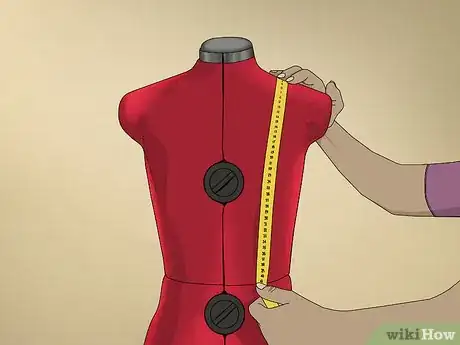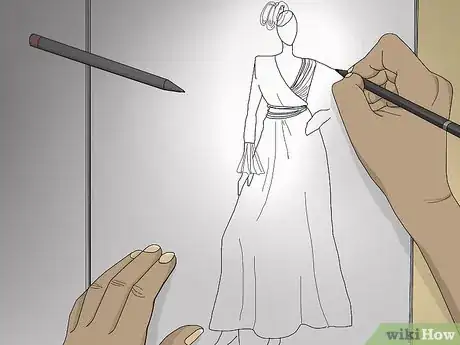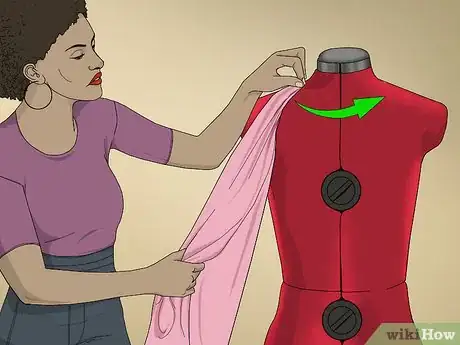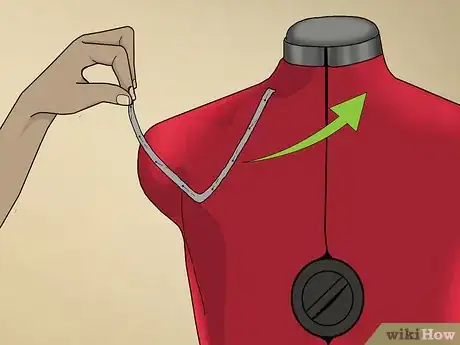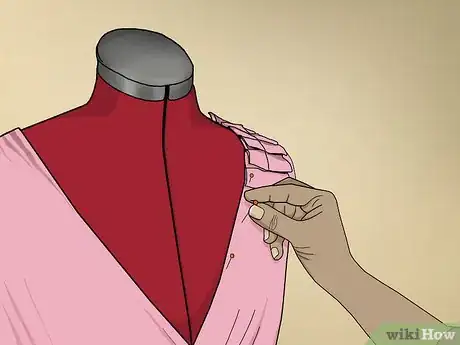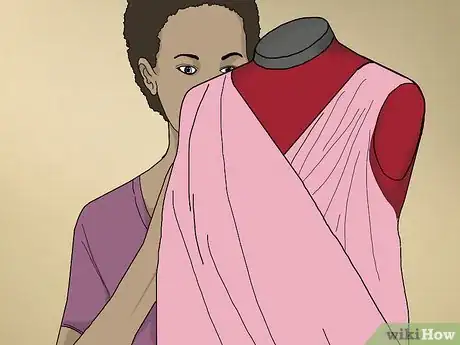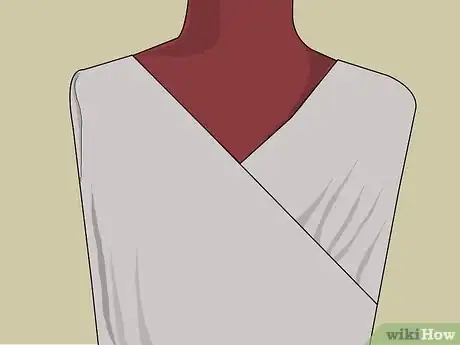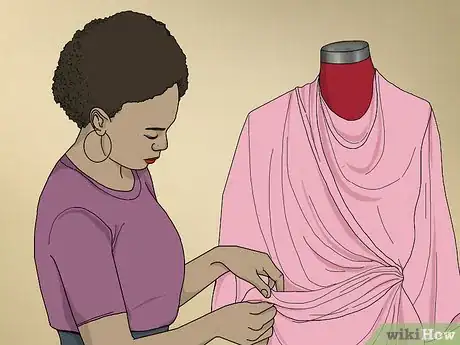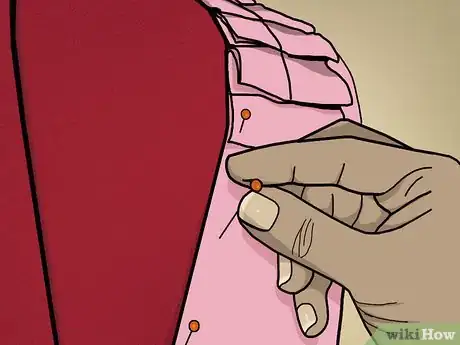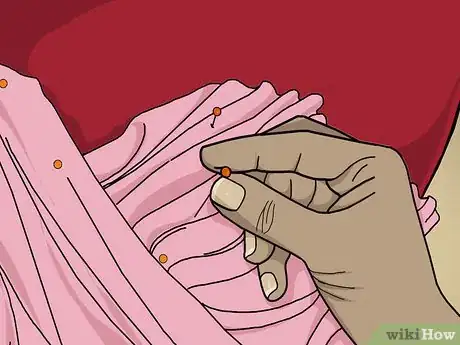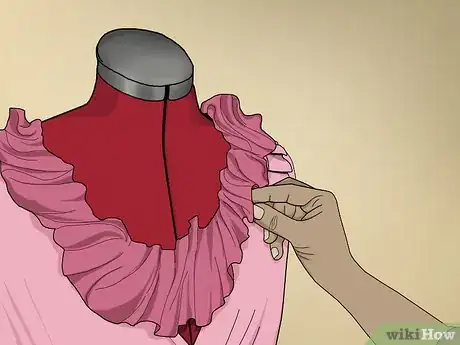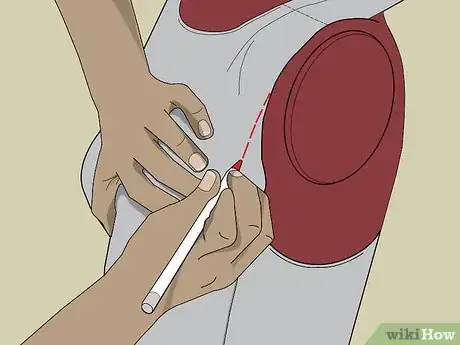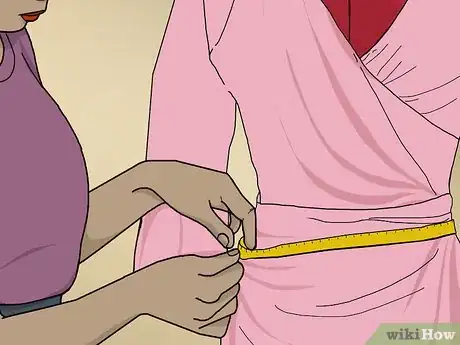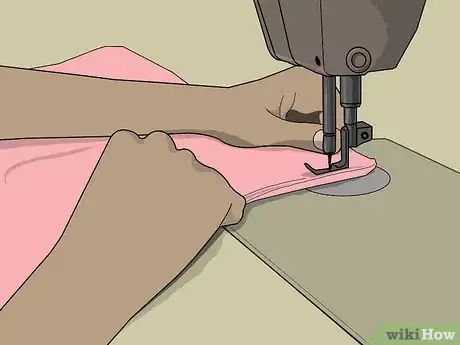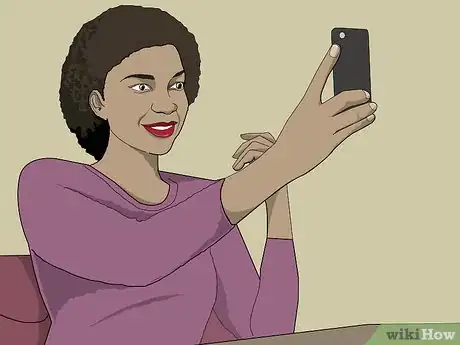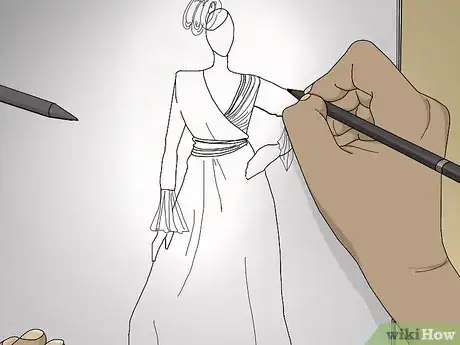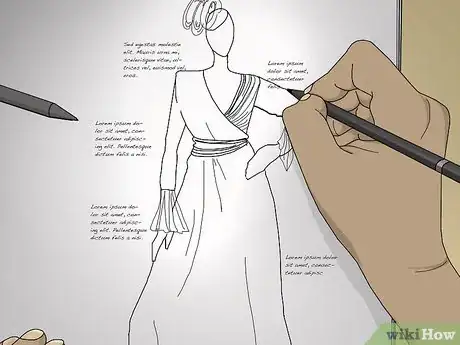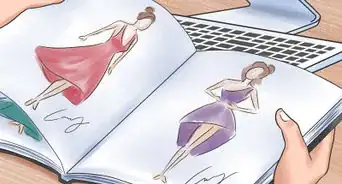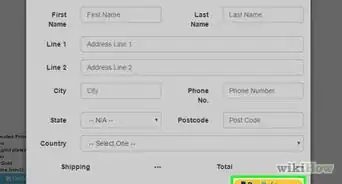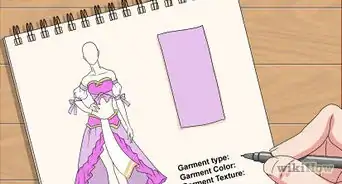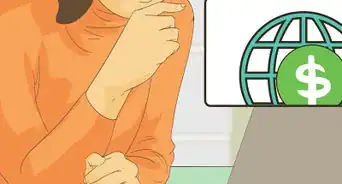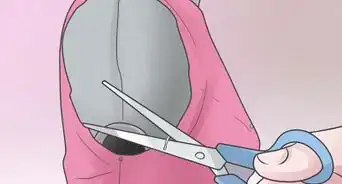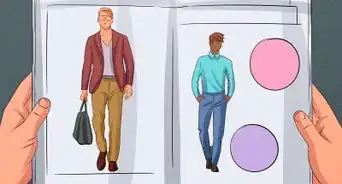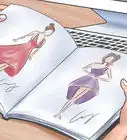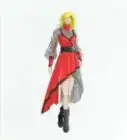This article was co-authored by Alterations Express and by wikiHow staff writer, Danielle Blinka, MA, MPA. Alterations Express is a salon-style alteration and tailoring house with walk-in service, spacious dressing rooms, fitting specialists, and an extraordinary team of tailors and seamstresses at 13 storefront locations. With over 70 years of experience, they specialize in guiding individuals through a professional fitting, evaluating an alteration project on the spot, express alterations, and immediately providing pricing for any alteration. Alterations Express has been featured on multiple websites such as TheKnot.com.
There are 12 references cited in this article, which can be found at the bottom of the page.
This article has been viewed 23,835 times.
Fashion designers sometimes assemble their creations by draping fabric directly onto a dress form or mannequin, rather than working with flat patterns. Draping allows you to play around with different looks, quickly comparing them to each other by rearranging the fabric. Designers may choose to use draping to create one-of-a-kind pieces, or they may prefer to make their patterns through draping. Once you create your design, you can record the measurements from your draped fabric, allowing you to make a pattern.
Steps
Beginning Your Design
-
1Adjust your dress form to the desired measurements. You can use a dress form or a mannequin for fabric draping, but keep in mind that the final garment and pattern will be measured to fit the form used to create it. If you are designing a garment for yourself or someone you know, then it’s best to use a form that can be adjusted to fit that person’s measurements.
-
2Sketch a basic outline of the garment. While most of your design will be created on the mannequin, start with an idea of how you want your piece to look. For example, draw out the neckline, the shape of the garment, the length, and the sleeves.[1]
- This will help you develop your idea fully before you start actually making any alterations.
Advertisement -
3Begin on the right side of the dress form. Starting on the right side is traditional in fashion design. Stand to the right of the form and pin your fabric from that side.[2]
-
4Mark your neckline with ⅛-inch (3-mm) black tape or ribbon. Pin the tape or ribbon to the dress form to match your sketch. Cut the excess once you’ve created your neckline. This will act as a guide for creating your design, but it won’t be part of the final pattern or garment.[3]
- You can find black tape or ribbon at a craft store, sewing store, or online.
-
5Pin your fabric to the neck and waistline. Use fabric pins to attach the piece of fabric that you will use for your base or pattern to the form. Your fabric does not need to be cut or shaped at this point. Attach the entire piece of fabric you've chosen for that part of the garment to the form. You can use muslin or the fabric you want to use for a final product.[4]
- For example, you may be using a rectangle yard of fabric for the bodice of a dress. You would pin the entire yard of fabric to the dress form.
- When using muslin, you will use a pencil to mark the measurements so that you can create a final pattern for a garment.
- When using other fabrics, you can sculpt the actual garment itself.[5]
-
6Start your design on the bust if your garment is for a female. Mark the bust using your fabric pins. You’ll start with the apex of the bust, which is the highest point. This will allow you to create darts in your garment to shape around the bustline, if you prefer.[6]
- If you’d like, you can leave the garment billowy around the bust, rather than molding the garment around the bust.
- If you’re designing a garment for a man, you do not need to mark the bust of your design.
-
7Create a fabric base for your garment. This will later become the lining of the garment. Pin the fabric base around the dress form in the basic shape of the garment you're creating. Your goal is to get fabric onto the dress form so that you can start creating. Your fabric should be four inches longer than the measurements of your dress form and final pattern on each side.[7]
- For example, if the bodice of your dress is 17-inches (43-cm) long, then your fabric should be 25-inches (64-cm) long to allow an extra four inches on each side.[8]
- Your base does not need to be creative. You can go back and trim it once you've sculpted the actual garment.
Getting Creative with Your Garment
-
1Experiment with draping the fabric onto the dress form. Play with your fabric to create the look you want. You can create ruffles, ruching, pleats, a wrapped style, and any shape you can think of. This is the part of fabric draping where you get to use the artist inside you to create a designer garment.
- How you drape the fabric will depend on the part of the garment you're working on. For example, you might want to wrap fabric tightly around the bodice, then create a billowing skirt.
- Try different arrangements to create a fun, unique look.
-
2Use pins to create the look you want with the fabric. As you find a style you like, pin down your fabric. If you change your mind about a look, you can always remove or rearrange your pins. Seriously, you cannot overestimate the importance of having a lot of pins available while you work!
- If you’re making a pattern, mark your design with a pencil or fabric pencil.[9]
-
3Alter the fabric before you use it. Since working on a dress form can result in tight, flat designs, you can add pleats, bunches, or artistic detailing to your fabric before you start draping. This will allow you to create more artistic, sculptural designs.
- You can also vary the type of fabric that you use.[10]
-
4Attach objects to the dress form to create a unique design. Drape your fabric over the objects, then remove them and work with the excess fabric. You can either let it hang, or you can fashion it into a fun design detail. You can use this technique to create designs that are unique and different.[11]
- You may want to start simple and work up to creating unique designs. However, being a fashion designer does require you to tap into your creativity.
-
5Cut off excess fabric that is getting in your way. Don’t make your cuts until you're sure that you don’t want to rearrange the fabric. However, if you’re sure that the fabric is just in the way, go ahead and snip it off with your fabric scissors. Then you can fold and tuck the edge of the fabric into the shape you want and pin it down.[12]
-
6Mark your pattern with a pencil if you’re creating one on muslin. As you work, mark the design features of your garment, such as the neckline, seams, and sleeves so that you can pull the muslin from the dress form and make the final pattern.[13]
- You may not want to mark on your fabric if it’s the fabric you’re using for a final garment, except for where you need to sew or add design elements.
-
7Avoid fighting gravity when you create your design. While you will need to pin the initial pieces of fabric directly to the dress form, let the fabric fall as it will when it’s worn as a garment. When you’re finishing up your design, remove as many of the pins holding the fabric to the dress form as you can so that you can get an idea of how the garment will hang when worn.
- For example, you can see if the straps start to fall down or if the skirt hangs flatter than expected.[14]
-
8Allow room for the wearer to move around. Using a dress form that is the size of the wearer will result in a garment that is skin tight, making it hard to wear. It may even be impossible for your wearer to move around, sit down, or raise their arms.
- How much extra room you allow will depend on your wearer and how tightly they like to wear their clothing. A good estimate is to add 2- to 4-inches (5- to 10-cm) to the bust area, .5- to 1.5-inches (1.25- to 3.75-cm) to the waist, and 2- to 4-inches (5- to 10-cm) to the hips. If the person has a larger body size than average, then you may need to add more fabric.[15]
- If you’re making a dress, you can also create a corset that fits your wearer to use as a base, ensuring that your garment will not be too tight.[16]
Finishing Your Garment
-
1Baste your fabric together. Use a sewing needle to attach the fabric pieces together in the shape you want.[17] To baste, lightly sew the seams with a basic stitch. You don’t need to create a good or straight stitch. It should hold the pieces together until you can sew the garment using your sewing machine.[18]
- Leave part of the garment un-sewn, such as where you will add the fastenings. This will allow you to remove the garment from the dress form.
- You do not need to baste your garment if you are using muslin to mark a pattern.
-
2Remove it from the dress form. First unpin the original pins that you used to attach the fabric to the form at the neck, waist, and possibly bust. Carefully slide the garment from the dress form without taking apart your design.
- If you are creating a pattern, then you can just unpin the pins holding the fabric to the dress form.[19]
-
3Sew your garment using a sewing machine. Follow along where you’ve pinned and basted your fabric pieces together. After you’ve made your final stitches, you can remove the basting if it’s not straight.[20]
- If you don’t have a sewing machine, you can sew your garment by hand. It will take longer, and you’ll need to make tight stitches.
-
4Add your fastenings. Sew your zipper, clasp, or buttons onto the garment.[21] If you want to add embellishments such as pearls or ornamental buttons, you can add those as well.
Documenting Your Design
-
1Take photos as you work. When you’re creating your design, you want to track your progress so that you can go back to an earlier stage if you decide you don’t like your final look. Photos will also help you recreate the design in the future.[22]
-
2Sketch out your design as you go. In addition to or instead of photos, you can sketch out a series of designs as you arrange the fabric, or you can add to a final design.[23]
- One option is to make sketches of designs that you like so that you can add onto them in different ways to create various looks.
-
3Make notes about your design. Jot down your thoughts about how the designs look, as well as what you might like to try again. It's a good idea to make notes about things you can't see in the photos or sketches. These details might be helpful for recreating your look.[24]
-
4Create a final pattern when your dress is complete. If you’re using muslin to make a pattern, use your draped fabric pieces to create your pattern. If you’re making a final designer garment, you can create a pattern based off of your sketches and photographs.
- Making a pattern is optional if you are trying to design one-of-a-kind pieces.
Things You’ll Need
- Adjustable dress form
- Fabric
- Camera
- Sketchbook
- Notebook
- Pen/Pencil
- Fabric pins
- Measuring tape
- ⅛-inch (3-mm) Black tape or ribbon
- Fabric scissors
References
- ↑ https://www.youtube.com/watch?v=KBtvl1-Wk3k&feature=youtu.be&t=6
- ↑ https://www.youtube.com/watch?v=KBtvl1-Wk3k&feature=youtu.be&t=28
- ↑ https://www.youtube.com/watch?v=KBtvl1-Wk3k&feature=youtu.be&t=39
- ↑ https://www.youtube.com/watch?v=KBtvl1-Wk3k&feature=youtu.be&t=199
- ↑ http://www.thecuttingclass.com/draping-and-moulage/
- ↑ https://www.youtube.com/watch?v=KBtvl1-Wk3k&feature=youtu.be&t=199
- ↑ http://bhsmistler.weebly.com/fashion/draping-fabric
- ↑ https://www.youtube.com/watch?v=KBtvl1-Wk3k&feature=youtu.be&t=161
- ↑ https://www.youtube.com/watch?v=dq8zUFOHCgY&feature=youtu.be&t=22
- ↑ http://www.thecuttingclass.com/draping-and-moulage/
- ↑ http://www.thecuttingclass.com/draping-and-moulage/
- ↑ https://www.youtube.com/watch?v=dq8zUFOHCgY&feature=youtu.be&t=32
- ↑ https://www.youtube.com/watch?v=dq8zUFOHCgY&feature=youtu.be&t=124
- ↑ http://www.thecuttingclass.com/draping-and-moulage/
- ↑ https://www.craftsy.com/blog/2015/04/ease-in-sewing/
- ↑ http://www.thecuttingclass.com/draping-and-moulage/
- ↑ http://bhsmistler.weebly.com/fashion/draping-fabric
- ↑ http://www.sewing.org/files/guidelines/15_105_running_stitch_basting.pdf
- ↑ http://bhsmistler.weebly.com/fashion/draping-fabric
- ↑ http://bhsmistler.weebly.com/fashion/draping-fabric
- ↑ http://www.thecuttingclass.com/draping-and-moulage/
- ↑ http://www.thecuttingclass.com/draping-and-moulage/
- ↑ http://www.thecuttingclass.com/draping-and-moulage/
- ↑ http://www.thecuttingclass.com/draping-and-moulage/
